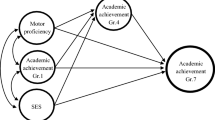Abstract
Relative age effects (RAEs), where older children within an age-based group have better academic, sporting, self-concept and mental health outcomes than their younger peers, have been demonstrated in multiple countries. Australian research has found self-concept and Attention Deficit Hyperactivity Disorder RAEs, but academic RAEs have not been explored. This cross-sectional observational study investigated RAEs among Western Australian year 3, 5, 7 and 9 government school students who took a National Assessment Program - Literacy and Numeracy (NAPLAN) test in Numeracy, Reading, Spelling, or Grammar and Punctuation in 2017. After adjusting for gender and Aboriginal and Torres Strait Islander status, we found that among the 98% of students who were in their recommended school year, younger students were on average significantly outperformed by their older classmates in all tests. RAEs were strongest in year 3, and progressively weakened through years 5, 7 and 9. These results are consistent with international research. They also support the hypothesis that age-related immaturity of relatively young children disadvantages them in academic competition, but this decreases as the age difference becomes a smaller proportion of their lived years. We also examined the performance of the 2% of children who were outside their recommended year. Accelerated students on average significantly outperformed their older classmates. Delayed progress students performed significantly worse than their younger classmates. A likely explanation for this reverse RAE is that accelerated students are often promoted because they are high academic achievers and delayed children are held back because they are performing below expectations.







Similar content being viewed by others
References
Australian Curriculum Assessment and Reporting Authority, ACARA. (2017). NAPLAN achievement in reading, writing, language conventions and numeracy: National Report for 2017. Sydney: ACARA. https://www.nap.edu.au/docs/default-source/default-document-library/naplannational-report-2017_final_2004dec2017.pdf?sfvrsn=2010.
Bell, J. F., & Daniels, S. (1990). Are summer-born children disadvantaged? The birthdate effect in education. Oxford Review of Education, 16(1), 67–80.
Crawford, C., Dearden, L., & Meghi, C. (2010). When you are born matters: The impact of date of birth on educational outcomes in England. IIFS Working Paper W10/06. London: Institute for Fiscal Studies, University College.
Department of Education Western Australia. (2017). Statistical Reports, Public and non-government schools with full-time students (by metropolitan, country and combined), Semester Two 2017. https://det.wa.edu.au/schoolinformation/detcms/navigation/statistical-reports/.
Edwards, B. T., Matthew, T., & Fiorini, M. (2011). Who gets the ‘gift of time’ in Australia? Exploring delayed primary school entry. Australian Review of Public Affairs, 10(1), 41–60.
Jackman, W. M., et al. (2019). Exploring gender differences in achievement through student voice: Critical insights and analyses. Cogent Education. https://doi.org/10.1080/2331186X.2019.1567895.
New South Wales Government. (2018). Starting school: Children who have a positive start to school are likely to engage and experience ongoing academic and social success. https://education.nsw.gov.au/public-schools/going-to-a-public-school/primary-schools/startingschool.
Parker, P. D., Marsh, H. W., Thoemmes, F., & Biddle, N. (2019). The negative year in school effect: Extending scope and strengthening causal claims. Journal of Educational Psychology, 111(1), 118–130. https://doi.org/10.1037/edu0000270.
Robinson, N. (2018, August 27). This year’s NAPLAN results of ‘very limited use’ and should be discarded, US experts argue. https://www.abc.net.au/news/2018-2008-2027/naplan-testing-reportsays-results-should-be-discarded/10160596.
Sax, L., & Kautz, K. J. (2003). Who first suggests the diagnosis of attention-deficit/hyperactivity disorder? The Annals of Family Medicine, 1(3), 171–174.
StataCorp. (2017). Stata statistical software: Release 15. College Station, TX: StataCorp LLC.
Sykes, E. D. A., Bell, J., & Rodeiro, C. V. (2009). Birthdate effects: A review of the literature from 1990-on. Cambridge: University of Cambridge.
Thompson, A. H., Barnsley, R. H., & Stebelsky, G. (1991). “Born to Play Ball” the relative age effect and major league baseball. Sociology of Sport Journal, 8(2), 146–151. https://doi.org/10.1123/ssj.8.2.146.
Whitely, M., Lester, L., Phillimore, J., & Robinson, S. (2017). Influence of birth month on the probability of Western Australian children being treated for ADHD. Medical Journal of Australia, 206(2), 85–85. https://doi.org/10.5694/mja16.00398.
Whitely, M., Raven, M., Timimi, S., Jureidini, J., Phillimore, J., Leo, J., et al. (2019). Annual Research Review: Attention deficit hyperactivity disorder late birthdate effect common in both high and low prescribing international jurisdictions: A systematic review. Journal of Child Psychology and Psychiatry, 60(4), 380–391. https://doi.org/10.1111/jcpp.12991.
Acknowledgements
This research was supported by a small grant from the Centre for Research in Applied Economics (CRAE) at Curtin University.
Author information
Authors and Affiliations
Corresponding author
Additional information
Publisher's Note
Springer Nature remains neutral with regard to jurisdictional claims in published maps and institutional affiliations.
Rights and permissions
About this article
Cite this article
Whitely, M., Phillimore, J. & Moorin, R. The effect of a child’s relative age on numeracy and literacy test results: an analysis of NAPLAN in Western Australian government schools in 2017. Aust. Educ. Res. 48, 249–265 (2021). https://doi.org/10.1007/s13384-020-00399-4
Received:
Accepted:
Published:
Issue Date:
DOI: https://doi.org/10.1007/s13384-020-00399-4




